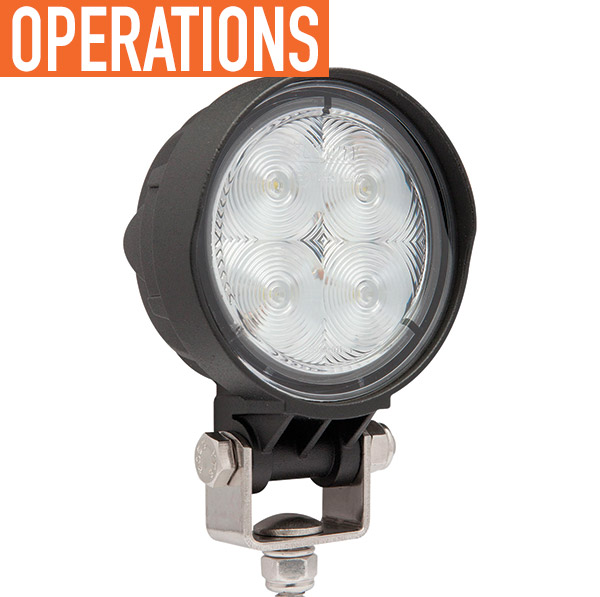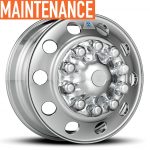Since its introduction to the commercial vehicle industry in 1989, LED lighting has been steadily gaining ground against far less reliable filament-based lamps. Once considered cost prohibitive by some service body manufacturers and work truck fleets, LED lamp prices have fallen exponentially over time.
The cost reductions follow the principles of Haitz’s law, forecasting that every decade the cost per lumen falls by a factor of 10, while the amount of light generated by each LED package increases by a factor of 20. Haitz’s law is essentially the LED equivalent of the more famous Moor’s law for computing power, and both laws are predicated upon gains due to process optimization.
“I would have to say that we are entering the twilight of the incandescent era in work truck lighting,” Brett Johnson, president and CEO of Optronics International, says. “As a practical matter, I can’t see why any fleet would still find value in spec’ing a vehicle with any incandescent lamps.”
DISPLACING COMPETITION
The features, advantages, and benefits of LED vehicle lighting are well known throughout the industry, as are the shortcomings of traditional incandescent lighting. Today, long-lasting, brighter, and more reliable LED lamps are rapidly replacing incandescent lamps on new and existing service vehicles and they are doing so at lower and lower prices.
Work truck applications include LED safety lighting (meeting all FMVSS 108 photometric requirements for visibility and safety) including stop, tail, turn, and marker lamps, scene lighting, compartment lighting, and new and more powerful LED work lamps.
THE NEW NORMAL
“The ratio of LED lamp sales vs incandescent lamp orders by OEMs is now surpassing 90/10,” Marcus Hester, vice president of sales and marketing for Optronics International, says. “There is a decisive movement toward LED lamps over incandescent lamps across the board in the commercial vehicle arena, and this includes tractors, trailers, and work trucks.”
“Though LED lamps are often used to replace failed incandescent lamps, repairs are still made by simply replacing one incandescent lamp with another,” Hester continues. “The ratio of LED lamp sales vs incandescent lamp sales within the service-related replacement market is about 70/30.”
Hester notes that the service and replacement market is following the OEM trend toward LED lighting, but that it lags behind because many vehicles originally equipped with incandescent lamps are still in service today. Though he adds, “Unlike LEDs, you won’t find many incandescent lamps on vehicles that haven’t been replaced multiple times.”
RELIABILITY AND COST
Today, competitive priced LED lamps, like Optronics International’s ONE Series single-diode stop/tail/turn lamps sell for only about twice the cost of an incandescent lamp, but last 50 times longer. And, like all LED lamps from Optronics, the ONE Series also has the added benefit of including a no-hassles lifetime warranty, effectively making them the only lamps a vehicle owner would need to purchase.
EMERGING WORK LAMPS
Optronics recently broadened its line of miniature LED work lamps with the introduction of its new Opti-Brite TLL30FB. At just 3.25 inches in diameter, the round lens of the new lamps is up to 35% smaller than comparable work lamps and, inch for inch, more powerful. The TLL30FB’s four LEDs produce a raw lumen output of 960, and its flood beam has an effective lumen yield of 670. The compact lamp is so small that it can be easily mounted on any vehicle with 4.5 inches of clearance and comes with a durable stainless steel mounting bracket.
Optronics also recently introduced a family of five new Opti-Brite Wide-Angle LED Work Lamps, with 40% broader beam patterns. In designing its new Opti-Brite Wide-Angle LED Work Lamps, Optronics used its advanced optical capabilities to create a contoured lens that delivers a broad, powerful beam pattern capable of illuminating 40% more viewing area.
An IP69K rating on all Opti-Brite LED work lamps also means that users within the work truck market can rest assured that their lamps will stand up to the hot, wet, and dusty environments they often encounter.
CONSOLIDATING FUNCTIONS
Optronics’ Fusion LED combination stop, tail, turn, and backup lamps were designed to give users the benefit of getting the functionality of two lamps for the price of just one. Additionally, because the lamps are all LED, they are far more dependable and thus safer than incandescent lamps. The original nine-inch oval combo lamp, introduced in 2014, is now available in four-inch round and six-inch oval formats and with grommet- and flange-mount models that will fit virtually any standard lighting application.

CHANGING ENVIRONMENT
“LED lighting has clear advantages in light quality, longevity, durability, power consumption, beam reach, and pattern control,” Johnson says. “LED lighting has replaced high intensity discharge (HID) lighting in many applications. Today, work trucks can be lit both inside and out with LED lamps. Any vehicle that has people operating it or working in it, on it, or in its vicinity needs lighting that addresses its specific application.”
Optronics works with OEMs to engineer lighting solutions that meet the needs of service vehicles that work in challenging environments. Optronics helps optimize the vehicle lighting for these environments, taking into consideration the work to be performed within them. The result is a happier, safer, and better performing workforce that’s more productive overall. More durable LED lighting is also longer-lasting, which reduces downtime and lowers repair costs.

LIGHTING COMPARTMENTS
With the advent of LED strip lighting, dark service truck compartments can now be brightly lit and much safer. The thin LED strips can be mounted virtually anywhere, allowing the tools, equipment, and other materials on shelf and in recess to be highly visible. Proper lighting means a lower likelihood of injuries to hands and arms and promotes the speed and efficiency of service professionals as they access the contents of service vehicle compartments.
SAVING ENERGY
No-idle laws reduce nitrogen oxide (NOx) emissions, soot accumulation, and diesel particulate filter (DPF) regeneration loads, but they put a much greater strain on the vehicle batteries of work trucks. Service calls due to battery failure is a huge issue and costs the fleet both time and money. Battery depletion can lead to alternator damage, as the alternator repeatedly has to overcome a battery’s low state of charge while managing other loads.
Work trucks must often operate autonomously, without the support of their diesel engines. The result is that operators often have to make hard choices as to what equipment can be operated and for how long, all while making sure that there will be enough power to start the vehicle’s engine, which in cold weather may require twice as much current.
Work trucks are also called upon to supply energy to run power tools, lift gates, hydraulic motors and truck-mounted equipment of all kinds while in remote locations. Telematics and other communications equipment, such as computers and mobile phones, round out the common parasitic energy users in the commercial work truck vehicle environment.
THE BALANCE OF POWER
“Lighting is quite simply foundational to the operation of commercial vehicles of all types,” Johnson says. “Adequate lighting is critical to the safety, convenience, and productivity of those who perform in, on, and around what is their workplace on wheels.”
In practical, real-world applications, today’s LED lamps use only 10 to 30% of the amps needed to illuminate incandescent lamps, depending on the application. More efficient LED lighting enables operators to redirect available power for their other electrical equipment needs.
LED lighting frees up energy that would otherwise go toward simply seeing one’s environment and enables one to be safer and more productive in that environment. The difference can translate into additional hours of operation that would simply not be possible in an incandescent lighting scenario.
“LED lighting also provides light quality that is the color temperature of natural sunlight and is therefore more conducive to human activity,” Johnson says. “With LED lighting, operators get more high quality lighting and they get if far more efficiently than with incandescent alternatives.”
FOR MORE INFORMATION:
Find out more about Optronics products and services, visit www.optronicsinc.com.
_______________________________________________________________________
MODERN WORKTRUCK SOLUTIONS: FEBRUARY 2017 ISSUE
Did you enjoy this article?
Subscribe to the FREE Digital Edition of Modern WorkTruck Solutions magazine.
![]()




